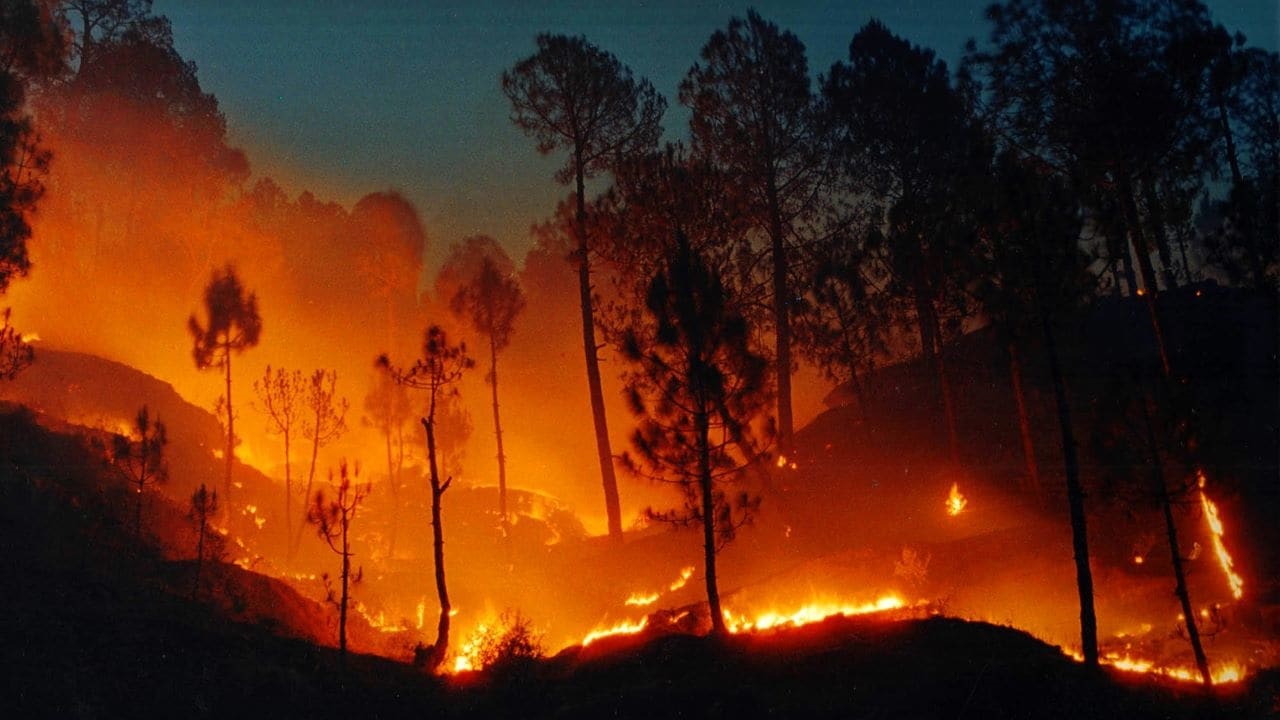Forest Fires in India: Causes, Consequences, and Solutions
Context: Why Are Forest Fires a Growing Concern?
Forest fires have become a major global issue, causing widespread environmental, social, and economic damage.
- Recent wildfires in Los Angeles destroyed homes, caused casualties, and led to large-scale evacuations.
- Forest fires often receive attention only after major disasters, but they are a recurring problem that requires continuous prevention and management.
- No region is immune, as forest fires are increasing worldwide, including in California, Australia, the Amazon, and India.
India, too, is witnessing a sharp rise in forest fire incidents:
- More than 36% of India's forests are prone to fires (Forest Survey of India).
- Forest fires have increased 10 times in the last 20 years, while India's forest cover has grown by just 1.12% (Council on Energy, Environment, and Water).
The Rising Forest Fire Crisis in India
India’s forests are crucial for biodiversity, climate regulation, and the livelihoods of millions. However, several states are facing frequent and severe forest fires.
- Himalayan states like Uttarakhand and Himachal Pradesh often make headlines due to forest fires.
- Madhya Pradesh, Maharashtra, Odisha, and Karnataka are also experiencing a rise in fire incidents.
- The dry season, combined with human activities, is making forests highly vulnerable to wildfires.
Consequences of Forest Fires
Forest fires have far-reaching environmental, economic, and social impacts.
1. Environmental Damage
- Loss of trees, plants, and wildlife, leading to destruction of habitats.
- Increased human-wildlife conflict, as animals move towards human settlements for safety.
- Disruption of the water cycle, reducing groundwater levels and leading to soil degradation.
- High carbon emissions contribute to climate change.
- Indian forest fires release 69 million tonnes of CO₂ annually (World Resources Institute).
2. Economic Losses
- Destruction of timber and non-timber forest products, affecting communities dependent on forests.
- Impact on agriculture and tourism due to loss of natural resources and scenic landscapes.
- Annual economic loss due to forest degradation, including fires, is estimated at ₹1.74 lakh crore (Ministry of Environment, Forest and Climate Change, 2018).
3. Social and Health Consequences
- Rising air pollution, causing respiratory diseases and other health issues.
- Loss of livelihoods for communities that rely on forest resources.
- Water shortages, as forests play a key role in maintaining water sources.
Major Causes of Forest Fires in India
Around 90% of forest fires in India are caused by human activities, including:
- Deliberate burning for land clearing or agriculture.
- Slash-and-burn farming (also known as shifting cultivation).
- Unattended campfires and burning of waste materials in forested areas.
- Illegal activities like poaching and logging, which increase fire risks.
- Rising temperatures and extended dry spells due to climate change.
India’s Measures to Control Forest Fires
Several policies and schemes have been implemented to manage and prevent forest fires:
- National Action Plan on Forest Fires (NAPFF) – Focuses on reducing forest fire risks.
- Forest Fire Prevention and Management Scheme (FFPMS) – A centrally sponsored scheme to help state governments improve fire management efforts.
However, challenges remain in funding, technology, and community participation.
1. Budget Constraints
The funding for FFPMS has fluctuated, affecting fire prevention measures:
- ₹46.40 crore (2019-2020)
- ₹32.47 crore (2020-2021)
- ₹34.26 crore (2021-2022)
- ₹28.25 crore (2022-2023)
- ₹40 crore (Revised for 2023-2024)
- ₹50 crore (Planned for 2024-2025)
Inconsistent funding makes long-term planning difficult.
2. Limitations in Technology
- The current Forest Fire Alert System struggles to differentiate between forest fires and other types of fires, leading to delayed response.
- Predictive modelling using weather and satellite data can help identify high-risk areas.
- Drones with thermal imaging cameras can improve monitoring and firefighting.
- Tamil Nadu and Odisha have piloted such technologies, but national-level implementation is needed.
3. Need for Greater Community Involvement
- Early detection and reporting by local communities can help prevent major fire outbreaks.
- Mobile applications, SMS alerts, and toll-free helplines can strengthen early warning systems.
- Women’s self-help groups in Uttarakhand and Himachal Pradesh collect pine needles to reduce fire risks.
- Nepal’s Community Forest User Groups and Indonesia’s Fire-Free Village Program offer models for involving local communities.
The Way Forward: Strengthening India’s Response
A comprehensive and well-coordinated strategy is required to effectively manage forest fires.
1. Improved Government Policies and Funding
- Ensure consistent funding for fire prevention and management.
- Enforce stricter regulations to prevent illegal land clearing and burning.
2. Advanced Technology for Fire Prevention
- Develop AI-based models to predict fire-prone areas.
- Expand the use of drones and satellite data for real-time monitoring.
3. Strengthening Early Warning Systems
- Encourage local participation in fire detection and reporting.
- Train local communities in fire prevention and firefighting techniques.
4. Community-Based Approaches
- Promote awareness campaigns on fire prevention.
- Engage youth as ‘forest fire scouts’ to assist in monitoring and reporting fires.
- Adopt controlled burning techniques to reduce fire fuel in high-risk areas.
Conclusion
Forest fires pose a serious threat to India's environment, economy, and communities. While policies and programs exist, more needs to be done to improve funding, technology, and community participation.
A multi-pronged approach, involving government agencies, scientists, civil society, and local communities, is essential to effectively tackle forest fires and ensure the protection of India's forests for future generations.


.jpg)

Comments (0)